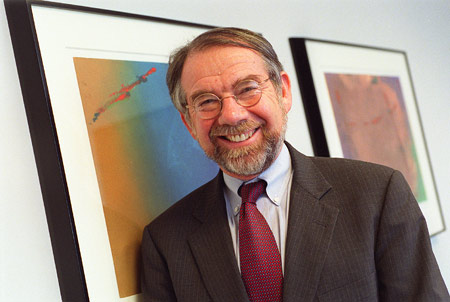Academy takes temperature of medical teaching

In an effort to improve medical teaching in an era when research is king and technology and societal changes are dramatically revising what it means to be a doctor, Harvard Medical School is launching an organization to recognize and support its best teachers and to innovate in medical education.
The Academy at Harvard Medical School inducted its first group of 140 members Feb. 25. Though most of the Academy is made up of faculty, some residents and students are included. Academy Director George Thibault, professor of medicine, said they are striving for a mix of ages and levels of experience.
The Academy’s organizers are hoping that this mix, coupled with the teaching excellence already exhibited by individual members and supported by the Academy’s resources, will help spur an improvement in teaching at the Medical School.
“The squeezing out of teaching as clinical care and research increasingly funded medical schools, as well as the changes wrought by HMOs and the explosive changes occurring in medicine itself, all lead to the need to rethink the way we teach,” Thibault said. “The problem is there is less time now for faculty to do that thinking.”
Thibault said the thinking fostered by the Academy will cover many different aspects of a medical education. A major focus, however, will be on the curriculum, and on such questions as how basic science is integrated into clinical education and where and how clinical education should be done in this changing environment.
Thinking about the Academy began more than a year ago, when Dean of the Faculty of Medicine Joseph Martin hired Daniel H. Lowenstein as dean of Medical Education. Lowenstein, who also serves as the Walter Professor of Neurology and Medical Education, had been on a task force on how to improve medical education at the University of California, San Francisco (UCSF).
“As I was trying to prepare a summary of our deliberations [at UCSF], it suddenly dawned on me that the problem we have is structural,” Lowenstein said.
The current system has done a marvelous job fostering advances in medical research and clinical care, Lowenstein said, as evidenced by the dramatic advances in medicine in recent decades. It has lagged, however, in improving the education of medical students.
The Academy is Harvard Medical School’s answer to the structural flaws in the system. By actively advocating excellent teaching, by being a new source of funding, and by advocating that excellent teaching be a strong consideration in reviews for promotion, organizers hope that the Academy will provide a counterweight to research and clinical care and make excellent teaching an equal priority.
“Now, for the first time, we have a mechanism to link together our most innovative faculty interested in teaching,” Lowenstein said. “It’s a very tangible presence in the structure [of Harvard Medical School].”
Martin first set up a senior faculty group to consider the idea, which soon led to a second group – of founding members, who gave the initial ideas flesh. In September, Thibault was hired as director and an office was set up, with a request for membership applications going out in November.
While Academy members already care deeply about teaching, being named to the organization does not end with the recognition. The Academy plans to be an active agent for change with a budget financed through the HMS operating budget, a grant from the University, and from endowment funds. The money will be used to sponsor training seminars, research new curriculum, examine new educational techniques, and support innovative efforts of Academy members and of all the teaching faculty. Thibault stressed that the Academy exists as a service organization for all teaching faculty of the Medical School.
To do that, the Academy will have stipends of $10,000 to $25,000 available to support its members’ efforts and will look to establishing endowed professorships with five-year terms. In addition it will make grants for special projects as well as establish “Academy Fellowships” for junior faculty, fellows, residents, or students interested in working with the Academy and learning more about teaching and education.
Thibault said funding the Academy’s efforts properly is critical so the project doesn’t just heap more duties and responsibilities on members’ plates.
“We would just compound the problem if we said [to Academy members], ‘Just fit it in your existing schedule and resources,’” Thibault said.
The Academy also plans to reach out to other universities and to Harvard’s diverse schools to see what is working there.
“We need a lot of new ideas,” Thibault said. “We will experiment and we’ll find some things work and some things don’t.”
The measure of its success, according to Lowenstein, will not be whether it impacts its members, but whether the Academy’s work is felt across the School.
“The real measure of success of the Academy is not going to come by asking members of the Academy if it has impacted their professional life, it’s going to be asking all the teaching faculty at the medical school whether that’s the case,” Lowenstein said.




